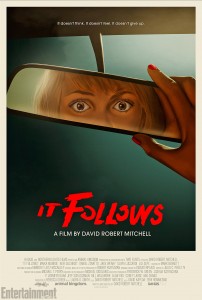I saw the film It Follows over the weekend, and it was pretty damn good: I love the premise, and I thought the execution was excellent, for the most part.
If you’re unfamiliar, It Follows is a horror film with a simple premise: A young girl has sex with a new boyfriend and is promptly informed that she has now been cursed: “It” will begin following her, and if it catches her, it will kill her. She can pass “it” on to someone else by having sex with them, but if that person is caught and killed, “It” will return its attentions to her. “It” can only be seen by the people who have been infected, and it takes various forms, all chosen to be particularly terrifying to each of its victims; this means sometimes “It” takes the form of loved ones.
“It” always walks at a steady pace, “It” always walks in a straight line, and “It” never stops.
The Heroic Heebie Jeebies
Now, for my money that premise rocks. Yes, the slut-shaming angle is a bit musty, but at least it’s unisex, but the relentlessness of “It” is horrifying. Something about the slow and steady approach of horrifying death that only you can see is effective.
Even better are the moments in the film when people are talking or doing something else, and you (the audience) become aware of someone (or something) approaching from the background. Naturally, you begin assuming “It” is always lurking, slowly walking towards the camera, and it is very effective at making you feel the dread that the characters must be feeling.
In fact, the one flaw of the film, I think, is that it doesn’t do this very often. There are only perhaps three moments in the movie (that I’m aware of) where extended shots show someone approaching from a distance, prompting this sort of dread. That dread is powerful, kids, and the film would have been better served, I think, to set up a few more sequences when you find yourself desperately searching the middle distance of the shot.
Diminishing Returns
Which prompts the question: If you have a powerful device in your story (or film), how often should you employ it? Once too many and it loses steam and can even become a joke. Not enough and you miss an opportunity. Certainly in It Follows if every scene had been a game of “spot It!” the effect would have worn thin very quickly, and become kind of boring and predictable by the end. While I think once or twice more, in variations, would have served the film well (and since it’s only 92 minutes long now, two more long sequences like that wouldn’t make it overlong), five or six more would have become kind of tedious.
So how do you know? It’s difficult. You want that magic number one less than boredom, so the rule of thumb should always be to use a device or technique only as often as you need to – once to establish it for the reader/viewer, once more to make it a technique instead of a one-off, and then … as many more times as you can get away with without cheapening the whole affair.
It Follows played it safe with its most powerful aspect, and that’s fine – it’s still a pretty good movie that kept my interest. But a little more of It Following might have made It Follows the creepiest movie I’ve ever seen.


“Always leave them wanting more.” P.T. Barnum.